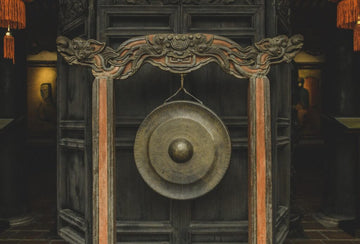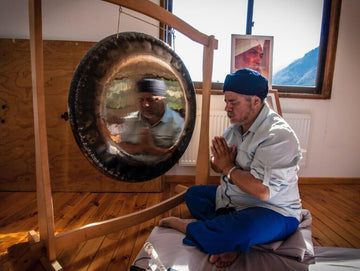
The most important facts in brief
- There are different statements about the age of the gong.
- The main centers of gong culture are Burma, China, Annam and Java.
- The gong was often used to transmit signals or was played during religious ceremonies or rituals.
- It was not until the 16th century that the gong came to Europe.
- Peter Hess has been integrating gongs into his concept of sound massage and sound methods since the end of the 1989s.
Where did the gong first appear in history?
There is speculation about the age of the gong: Some assume that the first precursors existed as early as the Bronze Age, i.e. 3,500 BC. Others refer to facts according to which the origins can be traced back to 2,000 BC.
Burma, China, Annam and Java are considered the main centers of gong culture, whereby the so-called "kettle drums", bronze kettle drums, are unanimously recognized as the forerunners of gongs. Various forms of gongs developed from this. Over the centuries, the various instruments spread to Japan via the famous Silk Road.

Note
Throughout Far Eastern culture, the gong has always played an important role in people's lives.
What was the gong used for in the past?
It was not until the 16th century that these fascinating instruments arrived in Europe by sea from Asia in the course of colonization. Due to their precious metal alloy and their often impressive artistic and tonal appearance, they were coveted commodities. Unfortunately, however, they were often only used as signaling instruments in bourgeois households to announce meal times or to represent the cosmopolitan nature of the home.
When did the gong come to Europe?
It was not until the 16th century that these fascinating instruments arrived in Europe by sea from Asia in the course of colonization. Due to their precious metal alloy and their often impressive artistic and tonal appearance, they were coveted commodities. Unfortunately, however, they were often only used as signaling instruments in bourgeois households to announce mealtimes or to represent the cosmopolitan nature of the home.
The entry of the gong into Western music culture
The actual entry into Western music culture can be dated back to 1889. At that time, the World Exhibition took place in Paris and Javanese and Annamite gamelan ensembles presented the music of their culture in the Dutch pavilion. The typical sound of gamelan orchestras, which developed into a high culture in Java and Bali in particular, is based primarily on gongs, gong rows and metallophones, which are supplemented by drums, stringed instruments, flutes and singing, depending on their size and purpose.
Claude Debussy and Maurice Ravel as pioneers of sound work with gongs
Claude Debussy was one of the first musicians to seriously explore the influences of this musical style. Maurice Ravel was also one of the pioneers, as he gave the gong its rightful place in his "Bolero". Many other musicians use this exotic instrument, even if its use has often been and remains limited to dramatic effects. In recent years, musicians such as Jens Zygar, Johannes Heimrath and Bardo have publicized the gong through international concerts.

Note
Peter Hess discovered the potential of gongs and integrated them into his concept of sound massage and sound methods at the end of the 1989s.






